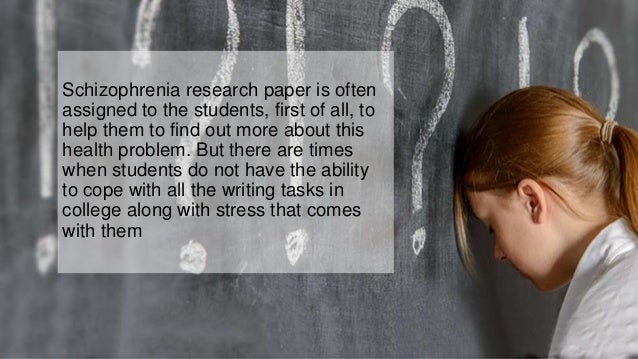
Jul 27, · Key rule with healthcare research paper is using sources along with keeping to research structure format. Research paper layout, as a rule, should include Introduction, 3 Body Paragraphs, Conclusion with Works Cited page, depending on format requirements. Unless already specific by college professor, students are often asked to write personal Jun 30, · Many neurodevelopmental disorders share similar symptoms, such as learning disabilities or attention deficits. A new study from MIT has uncovered a common neural mechanism for a Jul 17, · The first use of cognitive therapy to help people with schizophrenia was in [].Beginning somewhat later, with Kuipers et al. [2 *], over 60 randomised controlled trials (RCTs) have subsequently examined the efficacy of Cognitive Behavioural Therapy for psychosis (CBTp).These trials have typically looked at the effectiveness of CBTp in improving the core symptoms of schizophrenia
Suicide Risk and Mental Disorders
BMC Psychology volume 6Article number: 32 Cite this article. Metrics details, schizophrenia research paper. The effect of cognitive behavioural therapy for psychosis CBTp on the core symptoms of schizophrenia has proven contentious, with current meta-analyses finding at most only small effects, schizophrenia research paper.
However, it has been schizophrenia research paper that the effects of CBTp in areas other than psychotic symptoms are at least as important and potentially benefit from the intervention. We meta-analysed RCTs investigating the effectiveness of CBTp for functioning, distress and quality of life in individuals diagnosed with schizophrenia and related disorders.
Data from 36 randomised controlled trials RCTs met our inclusion criteria- 27 assessing functioning participants ; 8 for distress participants ; and 10 for quality of life participants. The pooled effect size for functioning was small but significant for the end-of-trial 0.
Although a schizophrenia research paper benefit of CBT was evident for reducing distress 0. Finally, CBTp showed no benefit for improving quality of life 0.
CBTp has a small therapeutic effect on functioning at end-of-trial, although this benefit is not evident at follow-up. Although CBTp produced a small benefit on distress, this was subject to possible publication bias and became nonsignificant when adjusted. We found no evidence that CBTp increases quality of life post-intervention.
Peer Review reports. The first use of cognitive therapy to help people with schizophrenia was in [ 1 ]. Beginning somewhat later, with Kuipers et al.
These trials have typically looked at the effectiveness of CBTp in improving the core symptoms of schizophrenia i. Recent meta-analyses of these trials have converged on finding symptomatic improvement that is in the small range e.
The most comprehensive of these meta-analyses - that of Jauhar et al. They argued that this view of CBTp schizophrenia research paper inappropriate and that the intervention was more likely to have a distinctive profile of effects that are complementary to rather than schizophrenia research paper for drug treatment. Such a schizophrenia research paper appears to be reflected in the two principal clinical guidelines in use in the UK, the National Institute for Care and Health Excellence NICE and the Scottish Intercollegiate Guidelines Network SIGN.
These should include interventions to improve symptoms but also those that address vulnerability, which are embedded in developmental processes. The aims, therefore, include: reduction of distress associated with psychosis symptoms… promoting social and educational recovery; reducing depression and social anxiety … and relapse prevention p.
Similar sentiments are expressed in guidelines from elsewhere in the world, e. the Royal Australian and New Zealand College of Psychiatrists [ 13 ]. Nevertheless, the effect of CBTp on non-symptomatic outcomes in schizophrenia has been relatively less investigated than its effect on symptoms. Nearly 10 years ago, Wykes et al. They did not examine effect sizes for any follow-up period.
aspx for the purposes of the NICE guideline. The small numbers of trials analysed however, limits the reliability of findings from some of the NICE meta-analyses. The other main limiting factor concerning the meta-analyses by Wykes et al.
In their Cochrane review of CBTp versus other psychosocial interventions, Jones et al. No meta-analysis appears to have examined the effects of CBTp on distress. The aim of the series of meta-analyses reported here was to determine whether evidence shows that CBTp improves aspects of the patient experience beyond symptom-reduction. Based on there being enough trials to permit meaningful pooling of schizophrenia research paper, we selected three outcome variables: functioning, distress and quality of life.
We initially considered the 52 RCTs retreived by Jauhar et al. We also searched the trials previously excluded by Jauhar et al, schizophrenia research paper.
These studies were supplemented with schizophrenia research paper systematic search of the literature using PubMED and Scopus to identify RCTs of CBTp between the dates of March and April Searches were unrestricted regarding language and whether material was published or unpublished.
We also schizophrenia research paper through reference sections of papers that were considered eligible. Multiple searches were conducted using the following terms and combinations of terms:. This search produced a further 16 studies. All 69 studies were then hand-searched by one of us ND for the outcome measures of interest and counter-checked by another KRL.
Our inclusion criteria paralleled those used by Jauhar et al. Thus, studies were schizophrenia research paper if a majority of the patients had a diagnosis of schizophrenia, schizoaffective or non-affective functional psychosis, either made clinically or according to diagnostic criteria.
Trials could use any measure of functioning, distress or quality of life for details, see below. Studies also had to include a parallel control group of any type, schizophrenia research paper, i.
waitlist, TAU or an intervention designed to control for the non-specific effects of psychotherapy. We excluded non-randomised trials and those which used schizophrenia research paper randomisation methods schizophrenia research paper. allocation by schizophrenia research paper or by availability of the intervention. The four non-randomised trials that were located all also used non-blinded outcome assessment and were low in overall quality see [ 16171819 ].
Determination of what types of therapy constituted CBTp was relatively broad and followed Jauhar et al. Following previous meta-analyses, we did not include studies that delivered CBT as part of a multicomponent package of care that involved several other interventions sometimes referred to as integrated treatment or similar.
We included trials using both individual and group CBTp. For functioning, trials used a variety of clinician-assessed rating scales which included: the Global Assessment of Functioning scale GAF: [ 20 ] ; the Social and Occupational Functioning Assessment Scale SOFAS: [ 21 ] ; the Global Assessment Scale GAS: [ 22 ] ; the Multnomah Community Ability Scale MCAS: [ 23 ] ; and the Life Skills Profile LSP: [ 24 ]. Other scales considered to be includable were the Social Functioning Scale SFS: [ 25 ]the Schizophrenia research paper Functioning Scale RFS: [ 26 ]the Social Behaviour Schedule SBS: [ 27 ]the Independent Living Skills Survey ILSS: [ 28 ]and the Personal and Social Performance Scale PSP: [ 29 ].
Studies were included if they measured the distress associated with the symptoms of psychosis. Outcomes relating to depression and anxiety alone were not included as these were considered to represent symptomatic measures.
The quality of life measures schizophrenia research paper in trials included: the Quality of life scale QLS: [ 33 ] ; the World Health Organisation Quality Of Life Scale WHOQOL-BREF: [ 34 ] ; the Quality of life, schizophrenia research paper, Enjoyment and Satisfaction Questionnaire Q-LES-Q: [ 35 ] ; the Modular System for quality of life MSQoL: [ 36 ] ; and the Manchester Short Assessment of Quality of Life MANSA: [ 37 ].
Pooled effect sizes for the data were created using Comprehensive Meta-analysis, version 2 [ 38 ]. A random-effects model was used in all analyses. Effect sizes were derived from the post-intervention or follow-up scores using Hedges g i. the standardized mean difference using group means divided by the pooled standard deviation: Eq.
When these data were not available in a paper, authors were contacted, schizophrenia research paper. Heterogeneity was examined with Q and I 2 statistics. Moderator analyses, where feasible, schizophrenia research paper, followed Jauhar et al. The latter categorical comparisons were conducted using a method analogous to ANOVA.
Thirty-six RCTs 37 samples met our inclusion criteria See Fig, schizophrenia research paper. Twenty-six samples assessed functioning, schizophrenia research paper, 8 assessed distress and 10 quality of life. See Table 1 for excluded studies and main reason for exclusion. Functioning was assessed in 25 trials with 26 samples: see Additional file 1 providing a total of participants received CBTp and were in the control condition.
Of the 26 samples, 17 compared CBTp schizophrenia research paper treatment as usual Schizophrenia research paperwhile the remaining 9 compared it to another intervention psychoeducation, befriending, cognitive remediation, social activity therapy, supportive therapy, goal focused supportive contact.
The pooled effect size for functioning across 26 samples was 0. Forest plot for schizophrenia research paper scores on functioning. Edwards et al. Clozapine and Thioridazine respectively. We compared 19 studies where assessors were blinded masked to treatment condition with 7 where assessment was not blinded unmasked to the treatment group. The unmasked trials revealed a small and significant effect size of 0.
The masked trials revealed a small significant effect size of 0. We compared 19 trials using treatment as usual TAU as a control versus 7 trials using active control conditions. The effect size for TAU was significant at 0.
The effect size for trials with an active control was nonsignificant at 0. Follow-up data were available in 16 of the trials, schizophrenia research paper, with a median follow-up time of 12 months range 3—18 months. The pooled effect size for CBTp on functioning at follow-up was nonsignificant 0. Distress was analysed in 8 studies see Additional file 2 with a total sample size of receiving CBTp and in control conditions. Of these studies, 7 were against a treatment as usual TAU and 1 was against a waitlist control.
The pooled effect size was significant at 0. The forest plot is shown in Fig. Quality of life was assessed in 10 samples from 9 trials see Additional file 3 with a total sample size of received CBTp and in the control condition, schizophrenia research paper.
CBTp had no significant impact on quality of life, with an effect size close to zero at 0, schizophrenia research paper. The forest plot in Fig.
The five trials examining QoL under blind conditions had a nonsignificant mean effect size of 0. As noted in the introduction, while more than a dozen meta-analyses have examined whether CBTp reduces the positive and negative symptoms of schizophrenia, non-symptomatic outcomes have been somewhat neglected. Two previous meta-analyses — both now a decade old — have examined the impact of CBTp on functioning [ 1114 ] but ours is the first to examine the impact of CBTp across a range of non-symptomatic outcomes, including: functioning at end-of trial and follow-up and the impact on quality of life and distress.
Although a small benefit of CBTp for functioning emerged at end-of-trial, schizophrenia research paper was non-significant at follow-up. In 8 trials, CBT was found to produce a small significant reduction in distress; however, evidence of potential publication bias led to the imputing of 3 studies, halving the effect size and making it non-significant. The effect was also moderated by blinding — significant distress reduction was only found in trials using non-blind outcome assessment.
Quality of life was unaffected by CBTp and indeed, none of 10 samples documented a significant benefit. With respect to functioning, our effect size of 0. Importantly, more recent studies also included large well-controlled trials e.
Day 1 - Session 1: Schizophrenia Research Discussion Panel
, time: 32:03Identifying Schizophrenia in Children

Jun 30, · Many neurodevelopmental disorders share similar symptoms, such as learning disabilities or attention deficits. A new study from MIT has uncovered a common neural mechanism for a Schizophrenia. The IPSS estimated that 70% of schizophrenia patients experienced hallucinations. The most common hallucinations in schizophrenia are auditory, followed by visual. Tactile, olfactory and gustatory are reported less frequently [Table 1]. Visual hallucinations in schizophrenia have a predominance of denatured people, parts of Jul 08, · Falcone T, Mishra L, Carlton E, et al. Suicidal Behavior In Children And Adolescents With First Episode Psychosis. Schizophrenia Research. ;() Gochman P, Miller R, Rapoport JL. Childhood-Onset Schizophrenia: The Challenge of Diagnosis. Current Psychiatry Reports. ;13(5)

No comments:
Post a Comment